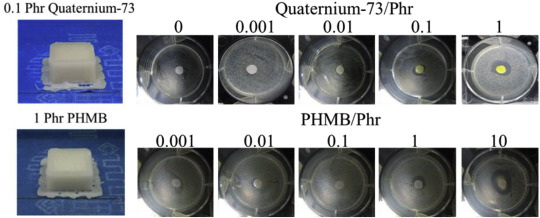University of Chemical Technology: Strengthening FDM 3D Printing with Starch Additive for PCL
Researchers from the University of Chemical Technology in Beijing continue the growing trend for strengthening existing materials with additives, outlining their findings in the recently published ‘Polycaprolactone/polysaccharide functional composites for low-temperature fused deposition modelling.’
While there are a wide variety of composites in use today, ranging from combinations like bronze PLA to carbon and epoxy—and a growing list of bio-inspired materials too—this study is unique as the researchers employed a melt blending technique while adding different ratios of starch. Composites are used for many different projects, manufacturing methods, and specific reasons—but for this research, the goal was to refine FDM 3D printing further by enhancing:
- Printability
- Tensile strength
- Rheological properties
- Crystallization behaviors
- Biological performances
FDM 3D printing is one of the most common methods used today, offering accessibility and affordability to users around the world.
“In the FDM process, the material has the very significant influence on the quality and function of the printed products,” stated the researchers. “Therefore, it has high theoretic meaning and realistic value to develop high-performance materials for FDM.”
Polycaprolactone (PCL) is a polyester offering many advantages on its own—from flexibility and machinability to being environmentally friendly and biocompatible; however, with the addition of other materials, some of the challenges in using PCL can be avoided too—preventing problems like inferior melting strength and low rate of solidification.
The composite was created as follows:
“PCL, soluble starch, corn starch and potato starch were placed in an air-blower-driver dryer at 50 °C for 2 h. After drying, 100 g of PCL was respectively mixed with 1 g, 3 g, 5 g, 7 g, 9 g and 11 g of each kind of starch. The mixtures were thoroughly blended with a high-speed mixer and then extruded by a twin-screw extruder.”
The researchers 3D printed their samples, measuring 20 mm × 20 mm × 10 mm, on a Replicator X2. They then examined parameters, antibacterial properties, in vitro cytotoxicity, and performed a statistical analysis with around three samples tested in each ‘time point.’
Samples were 3D printed using ‘pristine’ PCL, at temperatures of 70 °C, 80 °C, 90 °C and 100 °C. In terms of maintaining integrity and good melt flow, the researchers noted temperatures 80 °C and 90 °C. Clogging of the nozzle began to occur when the temperature was less than 80 °C.
“However, the quality of 3D-printed pristine PCL models was still lower than that of ABS,” stated the researchers.

General views of 3D-printed ABS and pristine PCL samples at different temperature (scale bar = 1 cm).
Starch was added, chosen due to suitable properties like particle diameter and thermostability, and affordability. Varying mounts were added to the PCL: 3 phr, 5 phr, 7 phr, 9 phr and 11 phr. The 3D model samples showed significant improvement with the addition of starch.

(a) Representative images of 3D-printed PCL/starch composites with various ratios of starch (scale bar = 1 cm); (b) FDM products prepared by PCL composite with 9 phr of starch (scale bar = 2 cm).
“The addition of starch enhanced the melting strength and solidification rate of PCL/starch composites. The starch increased the crystallization temperature, degree of crystallinity and crystallization rate of PCL/starch composites, which was beneficial for FDM process,” concluded the researchers.
“Furthermore, the quality of the printed products increased with from 3 phr to 9 phr. The completeness of printed model reached 99 with the starch ratio of 9 phr. When 11 phr of starch was added, the viscosity of the melt composite was too high and blocked the nozzle. Therefore, 9 phr was the optimal ratio of starch for 3D printing of PCL. The composite with 9 phr of starch had good performance in FDM process, which could be precisely manufactured into complicated constructions.”

Crystallization process of PCL/starch composites at the additive ratios for 1–11 phr by representative POM images.

(a) Images of antibacterial PCL/starch composite samples manufactured by FDM; (b) inhibition zones of antibacterial PCL/starch composites with different contents of quaternary ammoniym-73 and PHMB.
What do you think of this news? Let us know your thoughts! Join the discussion of this and other 3D printing topics at 3DPrintBoard.com.
[Source / Images: ‘Polycaprolactone/polysaccharide functional composites for low-temperature fused deposition modelling’]Subscribe to Our Email Newsletter
Stay up-to-date on all the latest news from the 3D printing industry and receive information and offers from third party vendors.
Print Services
You May Also Like
New Business: Temporary, Migratory, & Modular 3D Printed Architecture
If we look at potentially emerging 3D printing businesses, then architecture has not been fully explored. Yes, there is a lot of house 3D printing going on worldwide. From deployable...
3D Printing News Briefs, April 19, 2025: Material Extrusion Standard, Metal Powder, & More
In today’s 3D Printing News Briefs, we’re covering a proposed standard for material extrusion, before moving on to business and metal powder. We’ll end with a commercial store’s robotic 3D...
Japan Unveils World’s First 3D Printed Train Station
Japan is now home to what we believe is the world’s first train station built with 3D printing technology. Located in Arida City, just south of Osaka, the new Hatsushima...
restor3d Raises $38M to Expand 3D Printed Orthopedic Implants
Backed by $38 million in new funding, restor3d is pushing ahead with the launch of four personalized implant lines, set to roll out in 2025 and 2026. This latest venture...




























